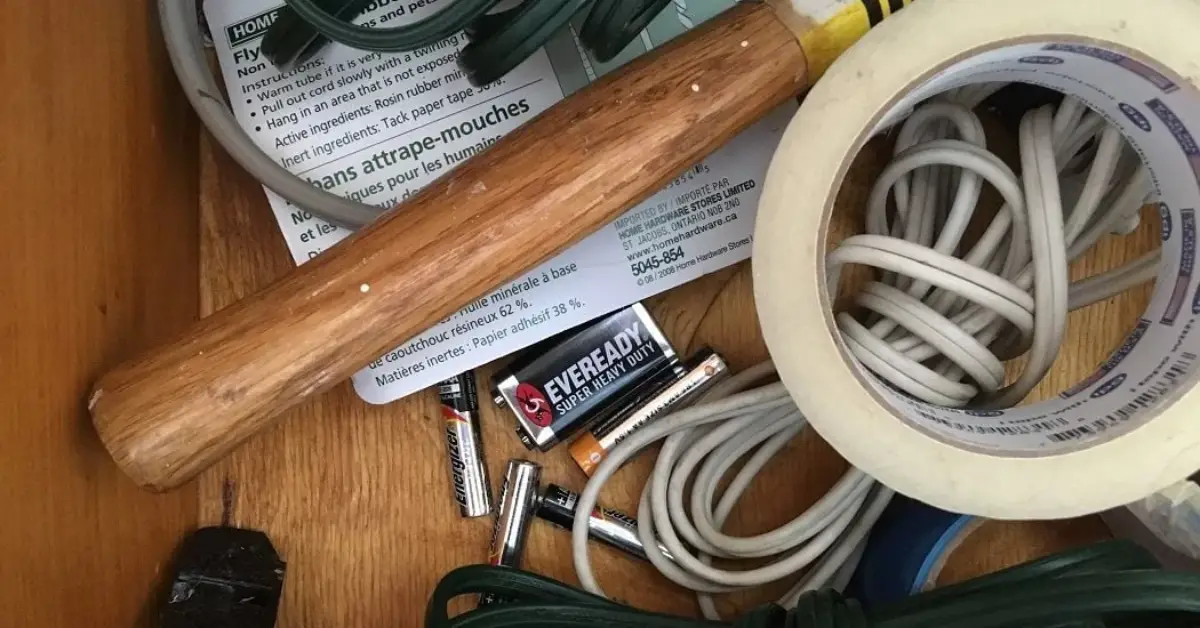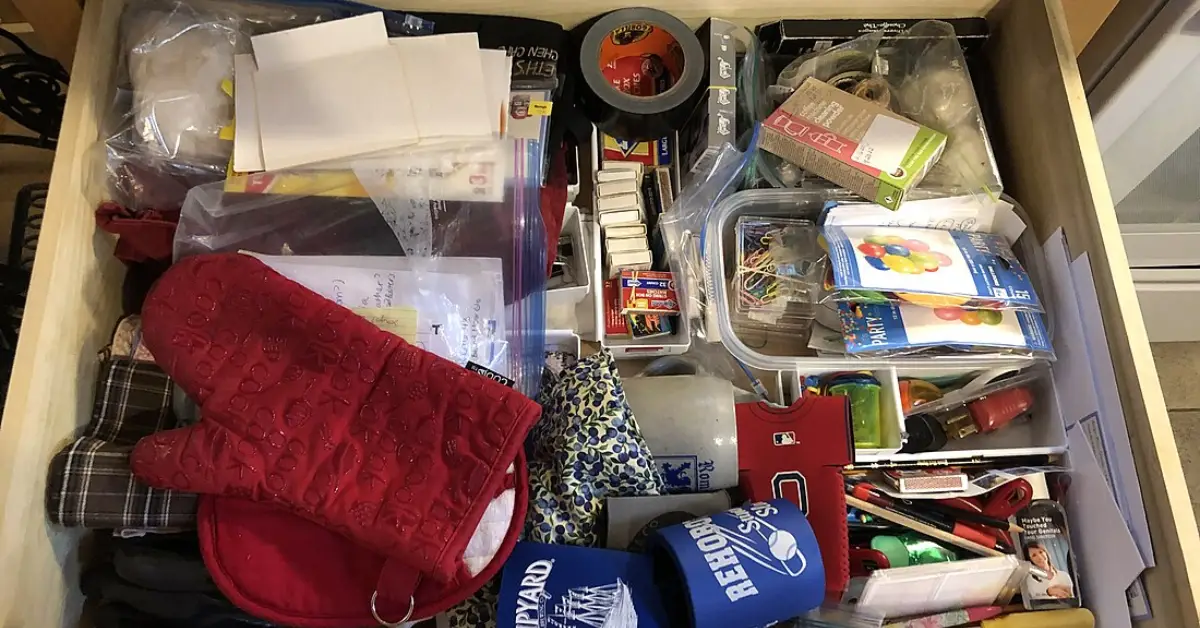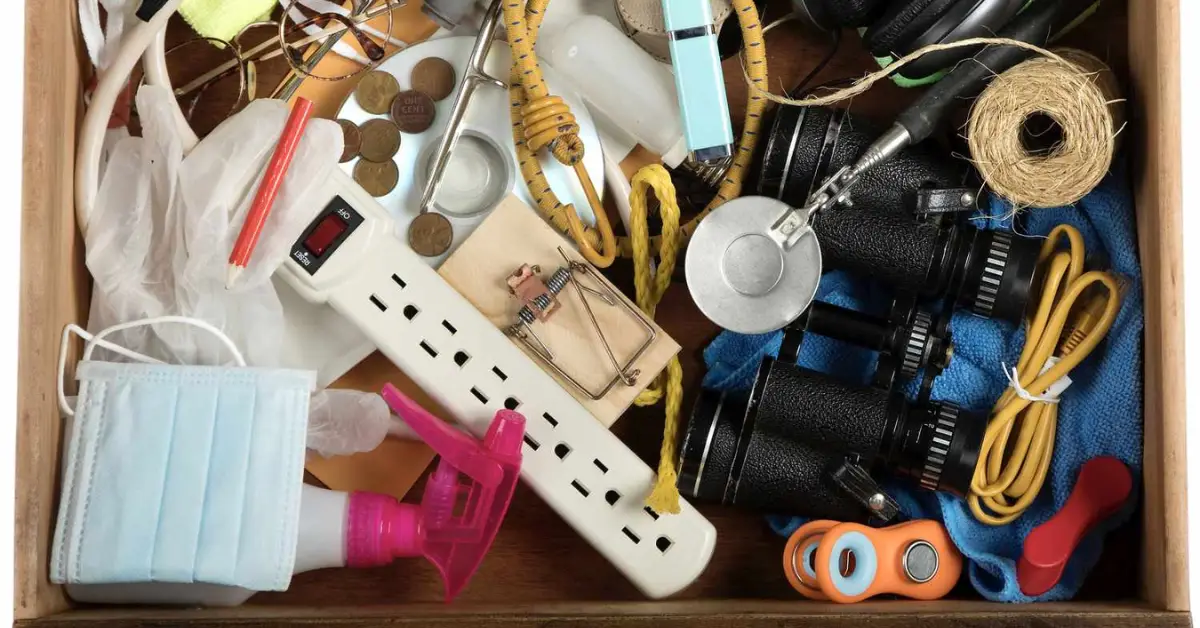7 Items You’re Hoarding Without Realizing It — Clean Your Drawer Today!
I’ve lost count of how many times I’ve opened my junk drawer, stared at the chaos inside, and thought, “I’ll clean this tomorrow.” You know the one — half-dead batteries, mystery keys, dried-up pens, and that phone charger from three phones ago. We call it a “junk drawer,” but let’s be honest — it’s more like a time capsule of things we didn’t have the heart (or time) to toss.
Here’s what most people don’t realise: that messy little drawer can actually hide a few real hazards. I’m not just talking about clutter — I’m talking about fire risks, chemical leaks, and even identity theft. It sounds dramatic until you learn what’s happening inside that mix of metal, paper, and plastic over time.
In this guide, I’ll walk you through seven surprising things that don’t belong in your junk drawer — and more importantly, why keeping them there could be doing real damage. By the end, you’ll know exactly what to pull out, what to keep, and how to make that drawer work for you instead of against you.
So, before you shut that drawer again and promise yourself “later,” take one last look — what’s really hiding in there?
Why Your Junk Drawer Isn’t as Harmless as It Looks
I used to think my junk drawer was just a harmless mess — a little chaos tucked neatly out of sight. But here’s the truth: that drawer isn’t as innocent as it looks. It’s actually a tiny hazard zone, packed with a mix of electrical, flammable, and data-sensitive items that were never meant to live side by side.
Think about what’s usually hiding in there: old batteries rolling around with coins, forgotten receipts full of personal info, maybe a lighter or two, and half-used tubes of glue. When those things sit together long enough, they don’t just make clutter — they create the perfect setup for short circuits, chemical leaks, and privacy risks.
The average household junk drawer contains around 52 random items. Fifty-two! That’s a mini ecosystem of forgotten stuff quietly collecting dust, moisture, and friction — the exact combination that can spark small fires or damage nearby items.
So before we talk about what to throw out, let’s look at the specific dangers you may not realise are sitting right under your nose. Before diving into these dangers, you might also like reading our quick guide on how to declutter your home in 3 simple steps with the 1-3-5 rule — it’s the perfect warm-up before tackling that junk drawer.
1. Loose Batteries: Tiny Power Cells, Big Fire Risk

Batteries are one of the most common things people toss into their junk drawer — and one of the most dangerous. I used to keep a handful “just in case,” until I learned how easily they can become a fire hazard.
Here’s what happens:
- Metal contact: When batteries touch coins, keys, or paper clips, they can create a short circuit that generates heat.
- Acid leakage: Over time, old or corroded batteries can leak, damaging wood surfaces and releasing harmful chemicals.
- Moisture buildup: Humid drawers speed up corrosion, making leaks more likely.
Fire safety experts warn that even small batteries, like AA or AAA, can start a smouldering fire if they connect with something conductive. The safest move? Store them in their original packaging or a small plastic case, not loose in a drawer.
2. Expired Medication and Pills
If you’ve ever found an old bottle of painkillers or vitamins buried under tape and pens, you’re not alone. But keeping expired medication in your junk drawer isn’t harmless — it’s risky.
Here’s why it matters:
- Chemical breakdown: Over time, medicine loses potency and can become unstable.
- Leaking containers: Moisture or temperature changes can cause pills or liquids to degrade, creating sticky or contaminated spots.
- Child and pet access: Junk drawers are often within easy reach, making accidental ingestion more likely.
The U.S. Food and Drug Administration (FDA) warns against tossing medications into household trash or storing them casually, noting that expired medicines should be disposed of through authorised take-back programs or pharmacy drop boxes.
So, if your junk drawer has become a hiding spot for half-empty pill bottles, it’s time to clear them out safely. Drop them off at your local pharmacy’s return bin — or, if that’s not available, follow the FDA’s disposal guidelines.
You’ll clear space, cut risk, and know that one small drawer isn’t quietly undermining your home’s safety.
3. Old Keys and Spare Locks — Security Weak Points
You might not think twice about the handful of old keys lying around in your junk drawer — the ones you can’t remember what they open but keep “just in case.” The problem is, those forgotten keys aren’t harmless relics. They’re potential security weak points just waiting to be misplaced or misused.
Here’s what most people overlook:
- Labeled keys with names or addresses can make your home an easy target.
- Old padlock or locker keys might still work on units you’ve never rekeyed.
- Loose spares kept next to mail or ID cards create an easy breadcrumb trail for anyone snooping.
I used to keep all my old keys together until I realised I’d basically built a ready-made break-in kit. Home safety experts like those featured in Good Housekeeping, recommend reviewing old keys regularly — if you don’t know what a key opens, it’s time to toss or recycle it. And if it belongs to your house or office, store it in a labelled key box instead of tossing it in a drawer.
4. Receipts and Paperwork with Personal Info

Receipts may seem harmless, but they can reveal more than you think. Between partial credit card numbers, loyalty codes, and store details, these scraps of paper quietly expose pieces of your identity. Stack them with bank letters or tax papers, and you’ve just created an unintentional data trail inside your drawer.
Worse still, receipts printed on thermal paper shed chemical ink over time, leaving residues that stain or transfer onto other items. And because paper feeds flames quickly, even a small spark can turn that cluttered drawer into a flash fire.
Here’s how to stay safe:
- Scan what matters using your phone and store it securely in the cloud.
- Shred or discard the rest once you’ve recorded them.
- Avoid storing any bills or bank statements in casual spaces like drawers.
Doing this not only clears clutter but also helps protect your privacy and financial information — two things you can’t afford to lose. If letting go of clutter feels tough, check out our post on decluttering made easy — 7 secrets to letting go of hard-to-discard items. It’ll make the process feel less overwhelming.
5. Matches, Lighters, and Candles
I once found a lighter wedged under a pile of papers in my junk drawer — and that was enough to make me rethink what I kept in there. Matches, lighters, and even small candles might feel harmless until you remember that heat, friction, and paper are a dangerous trio in tight spaces.
Here’s why they don’t belong there:
- Matches can ignite when rubbed against rough metal or sandpaper surfaces.
- Lighters leak fuel vapour over time, which can ignite from battery sparks.
- Candles stored near cords or batteries can melt or deform from ambient heat.
Even a tiny spark can start a smouldering fire that spreads before you notice. The fix is simple — keep all ignition-related items in a cool, dry, separate container away from electronics and paper. A small metal tin or dedicated safety box works best.
Your junk drawer should hold convenience, not danger. A two-minute check today could save you a lot more than cleanup later.
6. Random Electronics and Cords
If you’re anything like me, you probably have a tangle of old chargers, adapters, and cables shoved into your junk drawer “just in case.” The problem is, those cords aren’t just messy — they can actually become a hidden fire and shock risk over time.
Here’s what happens inside that clutter:
- Frayed cables can expose wiring that overheats or sparks when touched by metal items.
- Dust buildup acts like insulation, trapping heat and increasing the risk of melting.
- Mixing cords with batteries or metal objects can cause short circuits.
The Electrical Safety Foundation International (ESFI) warns that damaged cords and overloaded outlets are leading causes of electrical fires in homes. Storing electronics in tight, dusty spaces only adds to that danger.
Here’s how I keep it safer now:
- Use cord ties or Velcro wraps to prevent tangling.
- Keep a small “tech-only” bin for chargers, USB cables, and adapters.
- Toss anything that’s torn, burned, or outdated — if it looks risky, it probably is.
It’s a small change that makes your home safer and saves you the frustration of untangling wires every time you need one.
7. Mystery Packets, Old Glue, and Chemical Items

Every drawer has them — half-used tubes of super glue, dried hand sanitiser packets, or tiny bottles of who-knows-what. These little “mystery items” seem harmless, but over time, they can react with air, moisture, or even each other, releasing fumes or sticky residue that damage everything nearby.
Here’s what can go wrong:
- Old glues and sealants can leak or fuse to drawer surfaces.
- Chemical-based items like nail glue or sanitizer may emit vapours or discolor wood.
- Mixing old batteries with these items increases corrosion and surface damage.
Keep only what’s fresh and sealed. Store chemical-based items in a cool, upright container, ideally away from paper, batteries, or fabrics. Your drawers — and your air quality — will thank you.
Quick Drawer Safety Audit: What to Keep vs. Remove
Before you shut that drawer again, take five minutes to do this mini safety check. Use the list below as a guide — it’s quick, simple, and eye-opening.
| Keep | Remove Immediately |
|---|---|
| Pens, pencils, and tape rolls | Loose batteries or leaking battery packs |
| Small screwdrivers or tools | Expired medication or old pill bottles |
| Notepads, sticky notes | Old keys and labeled spares |
| Flashlight (with batteries stored separately) | Receipts, bills, or ID slips |
| Measuring tape or mini scissors | Matches, lighters, or open candles |
| USBs or small tech devices (in cases) | Old glue tubes, sanitizers, or chemicals |
Print this checklist and keep it handy, or download a quick version to pin on your fridge — that one-minute reminder can prevent months of buildup (and possibly a fire hazard).
Why a Clean Drawer Helps Mental Clarity Too
A clean drawer isn’t just about aesthetics — it actually changes how you feel. Every time you open that messy drawer, your brain registers it as another unfinished task. Cleaning it isn’t just about safety; it’s about reclaiming calm.
When your physical space is lighter, your mind follows. You’ll think clearer, find things faster, and start your day with a small but powerful sense of control. And that, honestly, feels better than any perfectly folded drawer could.
So go ahead — open it, clear it, and make that one square foot of your home a safer, calmer space to live in.
Drawer Detox Plan: 15 Minutes to Safer Storage
If you’ve made it this far, you’re already ahead of most people — because awareness is the first step. Now it’s time to turn that awareness into action. You don’t need an entire afternoon or fancy bins to fix your junk drawer. Fifteen focused minutes are all it takes to make it safer, cleaner, and easier to use.
Here’s a quick plan I use every few months:
- Empty everything out.
Lay it all on a table so you can see exactly what’s been hiding there. It’s the fastest way to spot leaks, rust, or duplicates. - Sort into three piles — Keep, Move, Discard.
- Keep: Useful everyday tools (pens, scissors, flashlight).
- Move: Items that belong elsewhere (keys, bills, chargers).
- Discard: Anything expired, leaking, or mystery-related.
- Wipe and refresh.
Clean the base with a damp cloth, then dry it completely. Moisture and dust are what cause corrosion and mold. - Rebuild with safety in mind.
- Use small organiser trays to separate categories.
- Keep batteries in a fireproof pouch or a dedicated container.
- Label sections clearly (“tools,” “stationery,” “tech,” etc.).
- Finish with a one-minute audit.
Ask yourself: “Would I feel safe if my child or guest opened this drawer?” If not, remove what doesn’t belong.
It’s amazing how much mental clarity a single clean drawer brings. Once your drawer is sorted, keep the momentum going by learning how to declutter your kitchen in 7 simple steps for a cleaner, happier space. You’ll be surprised how quickly small wins multiply. The next time you need tape or a charger, you’ll know exactly where it is — and you’ll know it’s safe to grab.
Final Thought: The 10-Second Rule for Drawer Decisions
Here’s a simple rule I’ve learned to live by:
If it can leak, spark, or expose personal information — it doesn’t belong in your junk drawer.
Every time you add something new, give it a ten-second test. If it fails, move it somewhere safer. That tiny pause keeps your home organised, your family protected, and your peace of mind intact.
Now it’s your turn — what’s the strangest or most unexpected thing you’ve ever found in your junk drawer?
Share your story in the comments below, and let’s see what surprises others have uncovered.
For more practical home improvement tips, smart safety ideas, and organisation guides, visit Build Like New — where simple fixes make your home feel brand new again.
Disclaimer: The information in this article is for general home safety and organisation guidance only. Always follow manufacturer instructions and local safety regulations when handling electrical, chemical, or flammable materials. Build Like New is not responsible for any damage or injury resulting from misuse or neglect of safety precautions.


